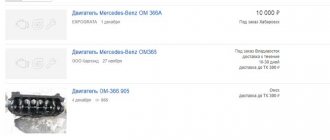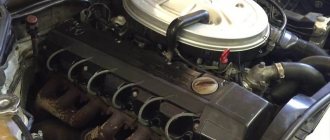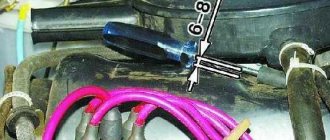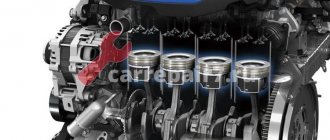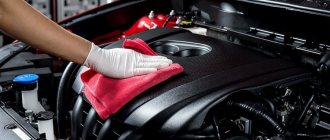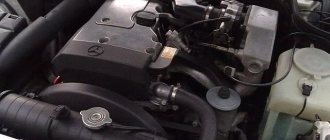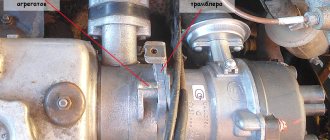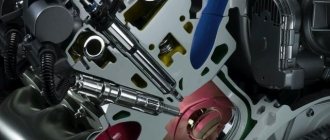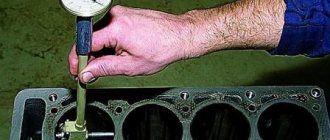In 1986, the Mercedes company staged an exhibition at the Munich Technical Museum. There, the company demonstrated the work of its most talented security engineer, Bela Bareni. It was he who came up with the idea of a body with collapsible safety zones and successfully implemented it in the Mercedes-Benz 220S W111. But due to some ridiculous mistake, it was not the 111 that was presented at the exhibition, but its predecessor, the Mercedes-Benz 220S Ponton. As a result, even now many people mistakenly believe that Ponton is the first car with crumple zones.
Mercedes-Benz W111
However, this cannot be called a gross mistake, since Mercedes carried out the first experiments with deformation zones on Pontoons. Be that as it may, Berenya’s ideas were only partially implemented in them. Therefore, when developing the new flagship, security issues were approached more thoroughly. In September 1956, the company's chief engineer, Rudolf Uhlenhout, assembled a group of experienced specialists, which in addition to him included motor mechanic Joseph Müller and bodyworker Karl Wilfert. The latter was assisted by Bela Barenyi, and Friedrich Geiger was responsible for the appearance.
It should be noted that in the late 50s, Mercedes did not have a serious financial and production base. Therefore, they tried to reduce the overall development budget by borrowing many parts from already produced machines. In addition, Geiger was directed to create a design that would not become outdated even after a decade.
At the front there was an independent suspension with double wishbones. Rear single-joint suspension with swing axle shafts
In August 1959, the Mercedes-Benz W111 entered mass production. At first, the car was produced only in a sedan body. The base engine was a modified in-line six M127 with 95 hp, borrowed from its predecessor. Under the hood of the top model Mercedes-Benz 220SE was the same engine, but with a Bosch injector and a power of 120 hp. Also from Ponton, the 111th received a rear independent spring suspension. Although thoroughly modernized. In addition, the car received archaic drum brakes on all wheels, and in the basic version, without a booster at all. This braking system clearly did not correspond to the dynamics of the car, and in 1963 the W111 was equipped with optional disc brakes.
Problems and reliability of the Mercedes M111 engine
The Mercedes M111 engine is an in-line four with a volume of 1.8 to 2.3 liters. These engines appeared in 1992 and were produced until 2006. Thus, their debut took place on the Mercedes W124. The latest Mercedes with this engine are the C-class W203, the SLK R170 roadster, and the CLK C208 coupe. But this engine lasted the longest on the Sprinter W905. Also, this power unit in a 2.3-liter version was installed on the Volkswagen LT and two SsangYongs - Musso and Kuron.
Among the M111 “fours” there were not only naturally aspirated engines, but also versions with a Roots-type compressor. Such versions with a volume of 2.0 and 2.3 liters debuted in 1995 on the C-Class W202. The weakest naturally aspirated 1.8-liter version developed 122 hp, and the most powerful 2.3-liter with a compressor produced 197 hp.
The M111 engines have a cast iron cylinder block and an aluminum 16-valve cylinder head. Of course, the valve drive contains hydraulic compensators. The intake camshaft has a phase shifter of an original design.
On our YouTube channel you can watch the disassembly of the 2-liter naturally aspirated engine M111.942, removed from the 1994 E-Class W210 136 hp. This engine is equipped with a Bosch HFM control system with a film flow meter.
You can select and buy an engine for the Mercedes W210 in our catalog of contract engines.
PMS unit W124, W202 and W638
From the very beginning, the engines of the M111 family received electronic fuel injection with a rather sophisticated PMS control system, which controlled both injectors and spark plugs. The PMS (Pressure Monitoring System) system was produced by Bosch and Siemens, and its essence is that it measured the load on the engine with an absolute pressure sensor. And this same sensor was integral with the control unit. The pressure sensor turned out to be delicate and short-lived, and if it failed, the entire unit had to be replaced. Later, these blocks were learned to be soldered together with the replacement of a failed pressure sensor. Engines with PMS have never been installed on the Mercedes W210. They went to the early M111 engines of 1.8 and 2.0 liters, for the W124, W202 and W638 models.
At the turn of the 2000s, the M111 engines evolved: the blocks were strengthened, the pistons and connecting rods were strengthened for an increased compression ratio. The cylinder head was also changed, and individual ignition coils appeared. If initially the compressor versions were equipped with an Eaton M62 supercharger, which was driven by a separate belt through an electromagnetic clutch, then the EVO versions received an Eaton M45 supercharger with a permanent supercharger drive.
We will be disassembling the 2-liter naturally aspirated engine M111.942, removed from the 1994 E-Class W210 136 hp. This engine is equipped with a Bosch HFM control system with a film flow meter.
Compressor
This is an Eaton M45 compressor from a 2.3 liter M111 engine. Such a compressor constantly rotates when the engine is running, creating excess pressure up to 0.37 bar.
From the manufacturer's point of view, the compressor is not repairable. However, sets of auger needle bearings are available for it. The bearings are the same for the M45 and M62 compressors.
Compressor wear is indicated by howling and even buzzing during operation, as well as the presence of aluminum dust and scratches on the augers.
You can select and buy a compressor for the Mercedes M111 engine in our catalog of contract spare parts.
HFM System Reliability
Early versions of the M111 engine for the E-Class W210 until 1997 were equipped with an engine management system with a then newfangled film flow meter, which more accurately calculates the amount of intake air.
This control system is more reliable than its predecessor (on M111 engines), but can fail due to a short circuit in the engine harness wiring or defective ignition coils. Fortunately, the HFM unit is repairable and can be restored by knowledgeable electricians.
Flow meter The full name of the film flow meter is HFM – hot-wire mass air flow meter with heated film. A mass air flow sensor of this type is still used today, but is already capable of sending a digital signal to the ECU.
The MAF engine M111 generates an analog signal. The functionality of this sensor can be checked with a voltmeter: the voltage on it should be in the range of 0.9-1 Volts. No more, which indicates incorrect sensor readings. The engine reacts to incorrect data from the mass air flow sensor with poor starting and unstable idling.
Malfunctions in the operation of the film mass air flow sensor arise due to oil and soot deposits on its sensitive elements.
You can select and buy a mass air flow sensor for a Mercedes engine in our catalog of contract spare parts.
Crankcase ventilation system
Often the crankcase ventilation system requires attention due to a violation of its patency. Usually blockages occur in the restrictor (it enters from below into the intake manifold) and in the tube coming out of the oil separator.
To check the patency of the VKG system, the easiest way is to remove the tube connecting the intake tract to the damper and the valve cover. You need to cover the hole on the valve cover with something (either your palm or a card) and check whether air is being sucked in. With the engine running, air should be well sucked into the valve cover, even with a slight increase in speed. If gas pressure presses from the valve cover, then the patency of the VKG system is impaired. Or there is too much crankcase gas in the engine due to wear on the CPG.
If there is any doubt about the patency of the VCG system, you need to get to the breather and the tube in front of it. True, they are located under the intake manifold and are difficult to access. In any case, they need to be checked if the engine begins to squeeze out oil through the seals.
Crankshaft position sensor
A well-known “sore” of the M111 engine is glitches of the crankshaft position sensor. The sensor fails due to heat. When the temperature is high, it does not give a signal, which is why the engine stalls and does not start until it cools down. It is curious that the engine management system on the M111 engines and its larger V-shaped counterparts does not register errors using the crankshaft sensor. You can revive the engine by watering the sensor. This way you can accurately determine the cause of the breakdown.
Throttle valve Throttle valves on 111 engines are of two types. On cars without cruise control and traction control, they can only control idle speed. With cruise and ASR (anti-traction control), the dampers are controlled by a separate unit and have more independence. Those. capable of both closing the damper and opening it completely. Such dampers can be distinguished from each other by their connectors: 8 contacts for a “simple” damper and 14 for a damper for cruise control and ASR.
Due to old age, the electronics of such dampers malfunction. The damper motor may fail or begin to operate intermittently. Also, the damper may begin to malfunction due to a violation of the insulation of its wiring - that part of the wires that is located in the housing. But problems with potentiometers of the damper position sensor practically do not occur.
In the case of electrical problems with the throttle, an error is recorded and noticeable problems with idle speed adjustment and strangeness in the response to the gas pedal occur. Also, due to a faulty throttle, the engine may stall when a side load appears: turning on the air conditioning compressor, turning the steering wheel.
If the throttle valve of the M111 engine is dirty, the symptoms are less obvious. For example, the engine does not start the first time, and this symptom can only appear on a cold or hot engine.
We also add that in Mercedes of the 1990s, problems with the throttle and many other electronically controlled components can be caused by a failure of the so-called “overload relay.” The soldering in it simply breaks down. Knowledgeable people proactively solder the contacts of this relay to avoid problems with anything: from the fuel pump to the throttle.
You can select and buy a throttle valve for the Mercedes M111 engine in our catalog of contract spare parts.
Communication between the throttle valve and the VCG system
Let's return to the crankcase ventilation system once again. Through the upper tube, the entrance to which is located in the intake tract after the mass air flow sensor and in front of the throttle, fresh air is sucked into the crankcase at low engine speeds. And at high engine speeds, crankcase gases are sucked out through this tube, and that part that is not filtered from oil vapors.
Thus, oil vapors have access to the throttle and can coat it, forming the well-known coating.
Also, oil vapors can be reflected from a sharply closed throttle valve, and thus even gain access to the flow meter.
We also add that in frosty weather, when the engine is not warmed up sufficiently, moisture and even emulsion also circulate through the upper tube of the VCG system. They can cause the throttle to freeze and form a thicker beige coating. This is the color of oil change mixed with moisture.
Actually, the abundant formation of moisture and condensation in the upper tube occurs due to the fact that the engine does not have time to warm up in frosty weather and evaporate all the moisture entering the crankcase with fresh air.
Phase shifter
For many years, a variety of Mercedes gasoline engines used an original variable-phase mechanism. On the M111 engine, the phase shifter clutch is located on the intake camshaft. The clutch is controlled by a solenoid connected to a hydraulic valve (solenoid). It is popularly called a “magnet”. It stands at the end of the camshaft, the solenoid (or “magnet”), at the command of the solenoid, moves the spool, thus opening the way for the oil driving the phase regulator.
Over the years and mileage, the spool, driven by a magnetic field, may simply jam in its channel. This usually happens during a cold start. The motor will begin to shake and an error will light up indicating the clutch. In many cases, removing the “magnet” and loosening the spool, which is located in the camshaft, helps.
Also, with long runs, the connector on the “magnet” may leak oil, which can be easily eliminated by disassembling the magnet housing and sealing it. If the phase shifter clutch knocks during operation, then the reason lies in a drop in magnet power. It will have to be replaced.
The clutch itself may also require replacement if, despite a moving spool and a working ECU, there is still a problem with phase regulation.
Injectors Due to clogged injectors, the engine idles unevenly, loses power, and there is a feeling of failure during acceleration. It has been noticed that Italian Siemens Deka Z1 injectors from the 2.5-liter Volga and Gazelle engines fit well and work well on the M111 engine.
You can select and buy injectors for the Mercedes M111 engine in our catalog of contract spare parts.
Ignition coils
The M111 engine has two dual ignition coils. These coils are sensitive to spark plug wear. Therefore, in case of problems with ignition, it is necessary to comprehensively evaluate the condition of the spark plugs and coils. An old spark plug can quickly damage a new coil.
Problems with ignition are indicated by failures during acceleration, tripping and strong floating speed, similar to the engine trying not to stall if one cylinder is turned off.
You can select and buy ignition coils for the Mercedes M111 engine in our catalog of contract spare parts.
Valve train chain
The chain runs more than 300,000 km. When stretching, the speed fluctuates and a slight clanging of the chain is heard. Engineers have provided the ability to clearly control chain stretch. To do this, you need to alternately fix the intake and exhaust camshafts and check the crankshaft offset. The camshafts are fixed with pins through special holes. If the crankshaft is offset relative to the intake camshaft by more than 30°, and the exhaust camshaft by more than 35°, then the chain must be replaced.
water pump
The M111 engine pump is considered a weak point. It just starts flowing over the seal.
Cylinder head gasket The cylinder head gasket of the M111 engine is short-lived. With a mileage of more than 300,000 km, sooner or later it will leak oil outward. Usually the leak appears on the front right, near the generator. To eliminate the leak, you will have to remove the “head” and change the gasket. It is strongly recommended to check the flatness of the cylinder head and also change the oil seals.
Piston group
The surviving M111 engines have traveled many hundreds of thousands of kilometers, so we can say that their cylinder-piston group is durable. The block can be sharpened; the manufacturer offers repair sizes for piston rings, pistons and all liners.
Oil burns in the M111 engine happen, and are caused by hardened valve stem seals and stuck piston rings.
You can choose and buy an engine for Mercedes in our catalog of contract engines.
Here, using the links, you can see the availability of specific Mercedes cars at the dismantling station and order auto parts from them.
